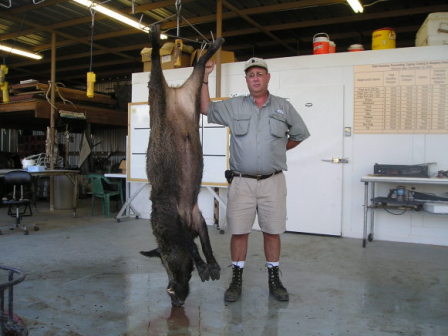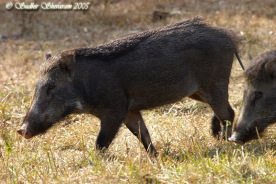This photo of a Maggie's Farm buddy with a big Texas pig, from a post last summer, elicited a comment from a reader saying that they had them in Wisconsin. Wisconsin? That was news to me. I thought "razorbacks" were more of a Southern and Western thing.
Happily, they have not invaded New England yet.

I knew about Texas, California, etc., and I checked his link. Yup. They are now found in 23 states. They are basically wild domestic pigs, but, depending on their location, the urban legend is that they may have some "Russian Boar" blood from game farms mixed in - but the domestic pig and the wild European boar are the same species: Sus scrofa. When breeding wild, feral pigs devolve into their natural form and habits. Unlike wild horses, they attract little sympathy, and they are not cute.
 In many areas of Europe, boar is extinct or endangered. In the US, these adaptable invaders are spreading fast, which is bad for forests but fun for hunters.
In many areas of Europe, boar is extinct or endangered. In the US, these adaptable invaders are spreading fast, which is bad for forests but fun for hunters.
Omnivorous, destructive of their habitat by aggressive rooting with their snouts, raising up to 4 litters per year, and ranging from 70-400 pounds in adulthood, these hardy, non-native critters are environmental destructos from hell. And their only real predator, to keep their numbers in any control, is man.
To make things more difficult, their shoulders, where you might wish to place a bullet, have very dense tissue which is difficult to penetrate. They are also potentially dangerous beasts who use their tusks as swords: they can easily kill a dog or seriously damage a human. On the plus side, they are highly edible.
Because most states have an open season on pig, hog hunting is increasingly popular - and environmentally necessary - whether with bow, shotgun, rifle (or even handgun, for the very brave or reckless).
Here's a piece on boar hunting in Ohio. Here's one from California.



 In many areas of Europe, boar is extinct or endangered. In the US, these adaptable invaders are spreading fast, which is bad for forests but fun for hunters.
In many areas of Europe, boar is extinct or endangered. In the US, these adaptable invaders are spreading fast, which is bad for forests but fun for hunters.
Thanks for the photo to a Texas reader who sent it in, in response to our piece on Wild Boar. But what's that in your friend's mouth - a piglet?
Tracked: Apr 16, 13:46
In the past year we have posted quite a bit on pigs. A reader was kind enough to send in his Show-and-Tell photo above of a recent Texas pig hunt. Is that a piglet his friend is holding in his mouth?Our contributor Gwynnie sent this note on Friday:This we
Tracked: May 08, 08:42
Gwynnie is going boar hunting in California again, this time with friend Chester, for whom it is a first time. We’re after Sus scrofa, the descendants of European boars imported for a “game farm”. We’ll actually use rifles in the .270-.308 range,
Tracked: Apr 30, 12:07